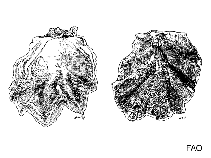Magallana sikamea (Amemiya, 1928)
Kumamoto oysterGoogle image | No image available for this species;
drawing shows typical species in Ostreidae.
Classification / Names Common names | Synonyms | CoL | ITIS | WoRMS
Bivalvia | Ostreida | Ostreidae
Environment: milieu / climate zone / depth range / distribution range Ecology
Benthic; brackish. Subtropical; 37°N - 17°N, 108°E - 134°E
Distribution Countries | FAO areas | Ecosystems | Occurrences | Introductions
Northwest Pacific: from Japan to South Korea, China and Taiwan.
Length at first maturity / Size / Weight / Age
Maturity: Lm ? range ? - ? cm Max length : 6.0 cm SHL male/unsexed; (Ref. 101471)
Life cycle and mating behavior Maturity | Reproduction | Spawning | Eggs | Fecundity | Larvae
Main reference
References | Coordinator | Collaborators
Camara, M. D., J.P. Davis, M. Sekino, D. Hedgecock, G. Li, C.J. Langdon and S. Evans 2008 The Kumamoto oyster Crassostrea sikamea is neither rare nor threatened by hybridization in the Northern Ariake sea, Japan. Journal of Shellfish Research 27(2):313-322. (Ref. 86665)
IUCN Red List Status
(Ref. 130435: Version 2025-1)
CITES status (Ref. 108899)
CMS (Ref. 116361)
Threat to humans
Human uses
Fisheries: commercial
| FishSource | Sea Around Us
Tools
More information
Max. ages / sizes
Length-weight rel.
Length-length rel.
Length-frequencies
Mass conversion
Abundance
Internet sources
BHL | BOLD Systems | CISTI | DiscoverLife | FAO(Publication : search) | Fishipedia | GenBank (genome, nucleotide) | GloBI | Gomexsi | Google Books | Google Scholar | Google | PubMed | Tree of Life | Wikipedia (Go, Search) | Zoological Record



